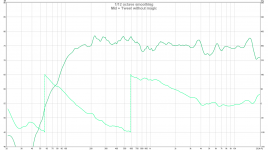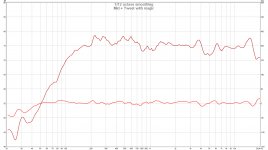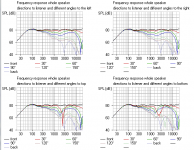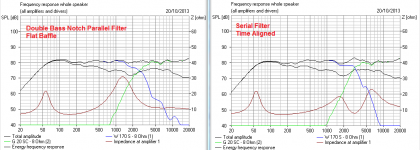supporters of fullrange drive units favor their 'coherence'. Technically what is coherence? can multi way speakers achieve it and how?
They gloss over that a single driver that can move air enough to be used as a bass driver and has good enough dispersion up high to be used as a tweeter doesn't exist.
If the absense of phase shifts is a design goal then it's easier today to just buy an off the shelf FIR DSP solution ( Like say the MiniSHARC ). In that case you could remove the low frequency phase shift also and get an even better speaker.
If the absense of phase shifts is a design goal then it's easier today to just buy an off the shelf FIR DSP solution ( Like say the MiniSHARC ). In that case you could remove the low frequency phase shift also and get an even better speaker.
Last edited:
If the absense of phase shifts is a design goal then it's easier today to just buy an off the shelf FIR DSP solution ( Like say the MiniSHARC ). In that case you could remove the low frequency phase shift also and get an even better speaker.
well I want to know what coherence really is. Can a DSP solution achieve this?
fullrange supporters would probably choose a DSP multi way if it really could do the same thing as a multi way which also gives a much wider frequency response.
So is coherence just imagined or is there really something superior about a full range driver? For example, the polar pattern would never be the same as a multi way would it?
Yes it can, a DSP can even do it better than a single full range speaker could ever do by removing said low frequency roll off shift and associated group delay.
It's not until the recent year that it has been an affoardable option since cheap ICs strong enough to handle enough FIR taps have emerged. Before that it was mostly the DIY dream where you had to use a PC for it.
There is much thought but if you look at what you can measure you can clearly see superior group time domain performance of vanilla multi way vs full range. A linear phase multi way has even better response and the dispersion of a multi way. Some discussion by linkwitz about the subject of time domain responses:
Here is some measurements of a midrange + tweeter crossed @ 3 khz, the first one is without FIR correction and the other with. Phase response is almost perfect on that one, and with todays cheap DSP it's easy. ( I used a MiniSHARC )
It's not until the recent year that it has been an affoardable option since cheap ICs strong enough to handle enough FIR taps have emerged. Before that it was mostly the DIY dream where you had to use a PC for it.
There is much thought but if you look at what you can measure you can clearly see superior group time domain performance of vanilla multi way vs full range. A linear phase multi way has even better response and the dispersion of a multi way. Some discussion by linkwitz about the subject of time domain responses:
Here is some measurements of a midrange + tweeter crossed @ 3 khz, the first one is without FIR correction and the other with. Phase response is almost perfect on that one, and with todays cheap DSP it's easy. ( I used a MiniSHARC )
Attachments
It's better to listen to one for yourself than trust someone else's subjective opinion. I can't think of any reason to choose full range over multi-way speaker, besides cost and simplicity of design.
Is multi way flawed?
With even the best speakers maybe 10% of the way, all speakers are flawed. One has to chose the flaws they find the least objectionable.
dave
supporters of fullrange drive units favor their 'coherence'. Technically what is coherence? can multi way speakers achieve it and how?
Hi,
It is relative phase/time coherence and the simplest way of looking
at it is the shape of the speakers reproduction of a square wave.
Multiway speakers can do it approximately at the cost of usually
some serious extra complexity, with some intrinsic problems.
Off axis variations are a problem with the low implied slopes.
Take a look at :
Vandersteen 2C loudspeaker Measurements | Stereophile.com
rgds, sreten.
Just because you can achieve a flat frequency response and a perfect schroeder group delay doesn't mean we have achieved the same as a perfect full range drive unit. With a multi way the time coherence can only be corrected at your particular listening position and sound bounces around at different times and intensities causing the brain to be confused.A linear phase multi way has even better response and the dispersion of a multi way
Just because you can achieve a flat frequency response and a perfect schroeder group delay doesn't mean we have achieved the same as a perfect full range drive unit. With a multi way the time coherence can only be corrected at your particular listening position and sound bounces around at different times and intensities causing the brain to be confused.
Wait, what?
What's to stop one from designing the multi way such that the time coherence is perfect off axis too? Say we use a coaxial for the bassmid + tweeter.
we use a coaxial for the bassmid + tweeter.
coaxial isn't what I meant by multi way. Coaxial is more like a full ranger unit. Multi way usually means 2 or more drivers on a baffle.
With single drivers the noise generated by the driver is the same for the full frequency band which is good. but with single drivers low level resolution is also compromised and so is out of midband frequency response. PICK your poison. There are always compromises, and those who believes that multiway DSP is the answer and the only way are as far from the truth as those claiming that only single drivers can work.
With single drivers the noise generated by the driver is the same for the full frequency band which is good. but with single drivers low level resolution is also compromised and so is out of midband frequency response. PICK your poison. There are always compromises, and those who believes that multiway DSP is the answer and the only way are as far from the truth as those claiming that only single drivers can work.
Those who enjoy fullrange drivers are certain that they hear something that the most expensive multi ways cant do despite the flaws associated with full range cones. There is something more we don't yet know about.
Its like you are the only one who dont know about it 😉There is something more we don't yet know about.
With even the best speakers maybe 10% of the way, all speakers are flawed. One has to chose the flaws they find the least objectionable.
dave
What he said 😀
Tony.
No better way of putting it.One has to chose the flaws they find the least objectionable.
But multi way it is, with it's own plus and minuses.coaxial isn't what I meant by multi way.
No better way of putting it.
But multi way it is, with it's own plus and minuses.
I was going to say that
well, forget perfect
recordings are not anyway
or musicians for that matter
and 10% 'flawed' will be like nothing 😛
coaxial isn't what I meant by multi way. Coaxial is more like a full ranger unit. Multi way usually means 2 or more drivers on a baffle.
A coaxial is a multiway.
dave
It's not a bad idea to read Lynn Olson to understand some of the different approaches to Loudspeaker design.
But in multiway, the object is to integrate two or more drivers as seamlessly as you can. As in laser interferometry, coherence means aligning the two sources on phase, and getting what you get with amplitude and diffraction. Seemples. 🙂
What's going on with Joachim Gerhard's lovely Canalis Anima speaker?
Mainly time alignment on a sloped baffle, which can integrate the units rather well. It will still LOBE above and below axis, of course. Which means the frequency response at crossover changes as you sit down or stand up. This is inevitable with physically separate drivers, though D'Appolito MTM designs and coaxial drivers behave differently.
All is not lost on a flat baffle. Just you have to work harder smoothing the bass rolloff with notches. I just throw in a simple serial crossover's curves for fun. They have some remarkable coherence when time aligned, even without treating with notches. 😎
Oh, BTW, group delay is the SLOPE of the Phase curve. Flat phase slope equates to simple time delay, and is not a problem. It's the lumps and bumps in the phase slope that equate to delay distortion and energy storage.
But in multiway, the object is to integrate two or more drivers as seamlessly as you can. As in laser interferometry, coherence means aligning the two sources on phase, and getting what you get with amplitude and diffraction. Seemples. 🙂
What's going on with Joachim Gerhard's lovely Canalis Anima speaker?
An externally hosted image should be here but it was not working when we last tested it.
Mainly time alignment on a sloped baffle, which can integrate the units rather well. It will still LOBE above and below axis, of course. Which means the frequency response at crossover changes as you sit down or stand up. This is inevitable with physically separate drivers, though D'Appolito MTM designs and coaxial drivers behave differently.
All is not lost on a flat baffle. Just you have to work harder smoothing the bass rolloff with notches. I just throw in a simple serial crossover's curves for fun. They have some remarkable coherence when time aligned, even without treating with notches. 😎
Oh, BTW, group delay is the SLOPE of the Phase curve. Flat phase slope equates to simple time delay, and is not a problem. It's the lumps and bumps in the phase slope that equate to delay distortion and energy storage.
Attachments
Last edited:
There are those that enjoy valve amplifiers, cables, cable risers, pebbles in jars,... Is there really something more we don't yet know about?Those who enjoy fullrange drivers are certain that they hear something that the most expensive multi ways cant do despite the flaws associated with full range cones. There is something more we don't yet know about.
- Home
- Loudspeakers
- Multi-Way
- Is multi way flawed?




